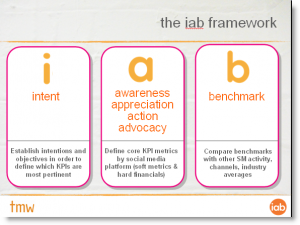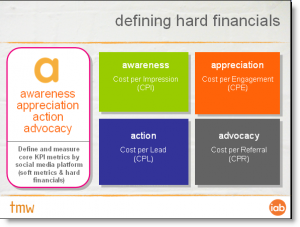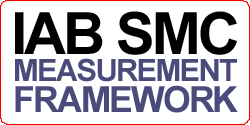One of the biggest ‘hot potatoes’ right now is how to measure social media activity and whether it’s possible to apportion ROI. It seems every man, woman and dog has an opinion on the matter!
And for good reason.
The days of whimsical experimentation have long gone. Nowadays, marketers have to justify every budget line with robust KPIs, solid business cases or definitive break-even/ ROI analysis. Not so easy when it comes to evaluating that ‘fluffy social media stuff’ but if we genuinely want this to be taken seriously it’s imperative we start making it much more accountable.
More accountability, more standardisation
But for this to happen there really needs to be a degree of standardisation across the industry so that we’re all talking the same language (or at least singing from the same ‘karaoke machine’!) But the truth is there’s currently too much inconsistency in the industry to draw any salient or meaningful conclusions. As it stands, it’s almost impossible to benchmark our respective activity as everyone is measuring performance differently. This is compounded by the fact that social media is so versatile, diverse, complex and multi-faceted, spanning many disparate objectives and many different platforms - no wonder we’ve struggled to find a common methodology which works across everything.
A step in the right direction
What I’m about to share with you may not address all these challenges but will hopefully move us in the right direction. TMW have been working in close consultation with the IAB Social Media Council to develop a new measurement framework to help practitioners evaluate their social media activity more effectively and consistently. It’s not rocket science. In fact, it’s a very simple framework, designed to be flexible enough to be applied across a broad spectrum of social media platforms, whilst at the same time giving practitioners the freedom to use their own experience and expertise to choose the most appropriate KPIs.
Rather serendipitously, the measurement framework we’re proposing shares the same acronym as the Internet Advertising Bureau, so at least it’s dead easy to remember!

You can view the full presentation of this approach below.
The presentation talks through each step of the process from establishing up front your intent, assigning the most pertinent KPIs according to the 4 As – Awareness, Apprecitation, Action and Advocacy – and consulting other benchmarks in order to draw meaningful comparisons.
There’s an array of KPIs which one can assign to each of these 4 As. As a starter for ten we’ve provided a selection to choose from but this list is not exhaustive by any means. Which KPIs you choose to apply will fundamentally vary according to the intent you define, the platform you’re using, the tracking you have in place and the internal expectations of various stakeholders and whether they demand hard financials as well as soft metrics.
Defining some hard financials
Ultimately, I believe we all need to be working towards some hard financials which over time will become established as industry standards. I’ve deliberately steered away from ROI per se – that’s a debate for another day – but instead would favour the four financial KPIs in line with the 4 As (see table below). How we calculate these KPIs is still to be defined but the principle of having one or more of this hard financials to evaluate or benchmark our activity could be extremely beneficial in my view.

Feedback welcome
The Council plans to officially promote this framework to the wider industry in a couple of weeks, but it would be great to get some feedback to ensure this is a collaborative effort. What we’ve outlined may not suit everybody but we believe it’s a step in the right direction and would encourage as many practitioners as possible to adopt it where they can. The more aligned the industry becomes, the more accountable social media will become and the easier it will be for all of us to digest the complexities of social media measurement.
Surely that’s something worth striving for?
by (vice SMC chair), Head of Buzz Metrics, nielsen
When something you don’t like reminds you of something you don’t like…
You know one thing I really don’t like? Sugar cubes. They really frustrate me. I mean, for something that is supposed to be so sweet and tasty, they are so annoying. Sugar cubes take forever to dissolve, and to speed up the process, I just keep stirring and stirring, making my drink cold. In addition, their form factor is supposed to be superior, but I don’t get it. I still have to use a spoon to take one and put it in my drink, just like granulated sugar. Also, there is no way to have a half a cube of sugar in my drink like there is with the other stuff. What is this post actually about, you ask? Well, I was at a meeting this week – stirring away – when I heard yet another major company talk about how they were ‘doing social media’ as they were ‘doing Facebook and Twitter.’ When I asked them why they were using these platforms, silence filled the room and puzzled expressions came across their faces.
You see, here is how many very well known companies seem to get involved in Social Media:
- First, an executive sees a presentation at an event, reads an article, or has a meeting with a consultant who talked about the Armageddon that is social media and the end of advertising models as we know them.
- This triggers a basic corporate reaction – the message flows downhill. This executive then turns to PR, Marketing, Brand, Research, etc. and tells them to put ‘Social Media’ on their list of objectives in 2010 and to go out and ‘do social media’.
- The final stage of this process includes the selected department determining that social media is Facebook and Twitter and therefore they launch a presence on these platforms.
Thus, when I ask them why they are doing this – i.e. what are their goals or objectives in using these platforms – they draw a blank. Social Media is a huge topic with so many activities, platforms, technologies, and aspects that it can overwhelm the most sophisticated and experienced business leader. The topic is so broad and vast, that trying to label or define it can become comical (just ask the IAB UK Social Media Council).
Rather than measure ‘social media,’ I believe companies should place much more emphasis on listening and using social media for strategy creation rather than jump right into execution or engagement. Listening and learning from this then can inform decisions to focus on destinations like Facebook and Twitter. Alternatively, companies and brands should look to define their objectives first, then determine if social media is a viable way to meet these objectives. For example, a brand may want to increase awareness, advocacy, retention, or churn, or decrease negative discussion and identify threats. A brand may want to begin to measure and treat each mention like an impression, something they are more familiar with measuring. Each of these components is much easier to breakdown into its individual parts and measure accurately and effectively. Otherwise, in my mind, social media measurement becomes as useful as a sugar cube.
Fleur MD of Pass it On Media was interviewed by IAB’s senior PR and marketing manager, on social media influencers. This 10 minute video covers how to spot a worthwhile influencer, how influencers help campaigns and how they can be detrimental in a PR crisis. Fleur talks through the processes at Pass it On on how to recognize a worthwhile influencer, what tools they use for this and how important it is to keep an influencer fully involved with the campaign and be honest and transparent throughout the whole process in order to gain the best results.
At the end of the video Fleur also mentions her involvement with the IAB social media measurement sub group and how they are currently working towards setting actual usable metrics for the industry.




